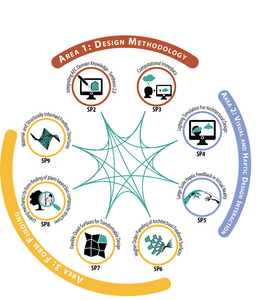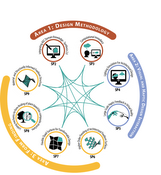Information
- Publication Type: Journal Paper (without talk)
- Workgroup(s)/Project(s):
- Date: August 2022
- DOI: 10.1002/bate.202200057
- ISSN: 1437-0999
- Journal: Bautechnik
- Number: 10
- Open Access: no
- Pages: 11
- Volume: 99
- Publisher: ERNST & SOHN
- Pages: 720 – 730
- Keywords: Building materials, CAD – IT/Automatical/CAD, design interaction, design methodology, Digital design/Optimization, digitalization, form finding, simulation
Abstract
Advanced Computational Design. The SFB Advanced Computational Design addresses the research question of how to advance design tools and processes through multi- and interdisciplinary basic research. We will develop advanced computational design tools in order to improve design quality and efficiency of processes in architecture and construction. The proposed research is structured in three areas: design methodology (A1), visual and haptic design interaction (A2) and form finding (A3). A1 focuses on the conceptual basis for new digital methods of design based on machine learning. A1 also acts as a platform for integrating and evaluating the computational tools and methods developed in A2 and A3. A2 investigates real-time global-illumination and optimization algorithms for lighting design, as well as a new method for large-scale haptic interactions in virtual reality. In A3, form finding will be explored regarding geometric, mechanical and material constraints, in particular: paneling of complex shapes by patches of certain surface classes while optimizing the number of molds; algorithms for finding new transformable quad-surfaces; mechanical models for an efficient simulation of bio-composite material systems. Furthermore, new ways of form finding will be explored through physical experiments, which will allow for reconsidering model assumptions and constraints, validating the developed algorithmic approaches, and finding new ones.Additional Files and Images
Weblinks
BibTeX
@article{wimmer-2022-acd,
title = "Advanced Computational Design – digitale Methoden f\"{u}r
die fr\"{u}he Entwurfsphase",
author = "Michael Wimmer and Iva Kovacic and Peter Ferschin and
Florian Rist and Michael Hensel and Kristina Schinegger and
Stefan Rutzinger and Hannes Kaufmann and Martin Kilian and
Christian M\"{u}ller and Ivan Izmestiev and Georg Nawratil
and Josef F\"{u}ssl and Milena Stavric and David Hahn and
Georg Suter",
year = "2022",
abstract = "Advanced Computational Design. The SFB Advanced
Computational Design addresses the research question of how
to advance design tools and processes through multi- and
interdisciplinary basic research. We will develop advanced
computational design tools in order to improve design
quality and efficiency of processes in architecture and
construction. The proposed research is structured in three
areas: design methodology (A1), visual and haptic design
interaction (A2) and form finding (A3). A1 focuses on the
conceptual basis for new digital methods of design based on
machine learning. A1 also acts as a platform for integrating
and evaluating the computational tools and methods developed
in A2 and A3. A2 investigates real-time global-illumination
and optimization algorithms for lighting design, as well as
a new method for large-scale haptic interactions in virtual
reality. In A3, form finding will be explored regarding
geometric, mechanical and material constraints, in
particular: paneling of complex shapes by patches of certain
surface classes while optimizing the number of molds;
algorithms for finding new transformable quad-surfaces;
mechanical models for an efficient simulation of
bio-composite material systems. Furthermore, new ways of
form finding will be explored through physical experiments,
which will allow for reconsidering model assumptions and
constraints, validating the developed algorithmic
approaches, and finding new ones.",
month = aug,
doi = "10.1002/bate.202200057",
issn = "1437-0999",
journal = "Bautechnik",
number = "10",
pages = "11",
volume = "99",
publisher = "ERNST & SOHN",
pages = "720--730",
keywords = "Building materials, CAD – IT/Automatical/CAD, design
interaction, design methodology, Digital
design/Optimization, digitalization, form finding,
simulation",
URL = "https://www.cg.tuwien.ac.at/research/publications/2022/wimmer-2022-acd/",
}



